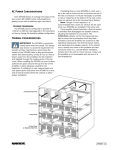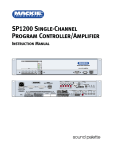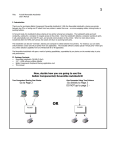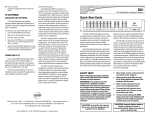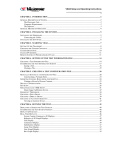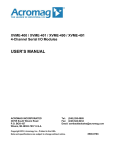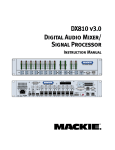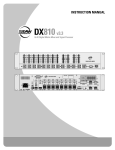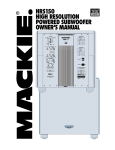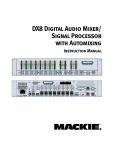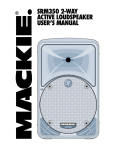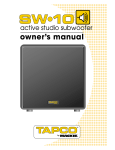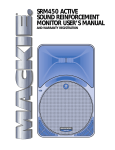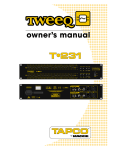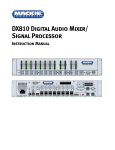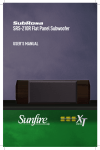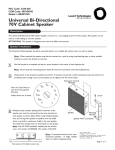Download Mackie SP2400 User's Manual
Transcript
SP2400 Dual-Channel Program Controller/Amplifier Instruction Manual MASTER VOLUME ZONE A MASTER VOLUME ZONE B 3 0 3 6 9 15 30 55 INPUTS 3 0 3 6 9 15 30 55 INPUTS SP2400 MUSIC CONTROLLER A B OVERLOAD 1 2 3 4 1 2 3 4 OFF 115V 60Hz FUSE 115/T8A 220 WATTS 230V 50Hz FUSE 230/T4A 220 WATTS DIRECT PAGING MIC PROGRAM INPUTS L THE FOLLOWING ARE TRADEMARKS OR REGISTERED TRADEMARKS OF MACKIE DESIGNS INC "MACKIE.","MACKIE INDUSTRIAL", AND THE "RUNNING MAN" FIGURE. COPYRIGHT ©2000 ALL RIGHTS RESERVED LOCAL 1 2 3 4 POWER COMM PORT MANUFACTURING DATE SERIAL NUMBER SP2400 MUSIC CONTROLLER ON STATUS OFF STEREO GROUND ALL CALL ZONE A ZONE B PARALLEL INPUTS PHANTOM G + – GAIN +40dB GAIN CONTROL LOW HIGH U U –12 +12 –12 +12 R 1 2 3 4 5 6 7 8 EXPANSION IN CAUTION: TO REDUCE THE RISK OF FIRE REPLACE WITH SAME TYPE FUSE AND RATING MIC/LINE INPUT B PHANTOM G B 1 2 3 G + – RS485 4 2 1 2 3 4 4 ON 3 - + MONO GAIN LOW HIGH U U REMOTE AMBIENT MIC - + –12 +12 –12 +12 LOW 80Hz MID FREQ HIGH 12k U U 1K U PRE OUT G + MIC/LINE INPUT A ZONE A – 400 PHANTOM OUTPUT SUITABLE FOR CLASS 2 WIRING + – 100/ 70V/8 A 3K G B 1 2 3 G + – GAIN I –15 +15 - + AMP IN –15 +15 250 8k –15 +15 HIGH U U GAIN +40dB RS485 REMOTE AMBIENT MIC - + –12 +12 –12 +12 MIC VOX LOW 80Hz MID U U FREQ HIGH 12k 1K U PRE OUT G 1 2 3 4 0 1 2 3 4 5 6 7 8 AMP ADDRESS LOW PROGRAM EQ PAGING STEREO LEFT MIC VOX GAIN +40dB 1 2 3 4 0 1 2 3 4 5 6 7 8 AMP ADDRESS 3 PROGRAM EQ PAGING STEREO RIGHT OUTPUT SUITABLE FOR CLASS 2 WIRING + – 100/ 70V/8 A 2 REMOTE 1 OUTPUT PRIORITY CONCEIVED, DESIGNED, AND MANUFACTURED BY MACKIE DESIGNS INC. • WOODINVILLE • WA • MADE IN USA • FABRIQUE AU USA ZONE B I 1 EXPANSION OUT 1 2 3 4 + – 400 –15 +15 - + AMP IN –15 +15 3K 250 8k –15 +15 CAUTION AVIS 8. Power Sources — Connect the SP2400 to a power supply only of the type described in these operation instructions or as marked on the rear panel. RISK OF ELECTRIC SHOCK DO NOT OPEN RISQUE DE CHOC ELECTRIQUE NE PAS OUVRIR 9. Power Cord Protection — Route power supply cords so that they are not likely to be walked upon or pinched by items placed upon or against them, paying particular attention to cords at plugs, convenience receptacles, and the point where they exit the SP2400. CAUTION: TO REDUCE THE RISK OF ELECTRIC SHOCK DO NOT REMOVE COVER (OR BACK) NO USER-SERVICEABLE PARTS INSIDE REFER SERVICING TO QUALIFIED PERSONNEL 10. Object and Liquid Entry — Do not drop objects into or spill liquids into the inside of the SP2400. ATTENTION: POUR EVITER LES RISQUES DE CHOC ELECTRIQUE, NE PAS ENLEVER LE COUVERCLE. AUCUN ENTRETIEN DE PIECES INTERIEURES PAR L'USAGER. CONFIER L'ENTRETIEN AU PERSONNEL QUALIFIE. AVIS: POUR EVITER LES RISQUES D'INCENDIE OU D'ELECTROCUTION, N'EXPOSEZ PAS CET ARTICLE A LA PLUIE OU A L'HUMIDITE 11. Damage Requiring Service — The SP2400 should be serviced only by qualified service personnel when: A. The power-supply cord or the plug has been damaged; or B. Objects have fallen, or liquid has spilled into the SP2400; or C. The SP2400 has been exposed to rain; or The lightning flash with arrowhead symbol within an equilateral triangle is intended to alert the user to the presence of uninsulated "dangerous voltage" within the product's enclosure, that may be of sufficient magnitude to constitute a risk of electric shock to persons. Le symbole éclair avec point de flèche à l'intérieur d'un triangle équilatéral est utilisé pour alerter l'utilisateur de la présence à l'intérieur du coffret de "voltage dangereux" non isolé d'ampleur suffisante pour constituer un risque d'éléctrocution. The exclamation point within an equilateral triangle is intended to alert the user of the presence of important operating and maintenance (servicing) instructions in the literature accompanying the appliance. Le point d'exclamation à l'intérieur d'un triangle équilatéral est employé pour alerter les utilisateurs de la présence d'instructions importantes pour le fonctionnement et l'entretien (service) dans le livret d'instruction accompagnant l'appareil. 1. SAFETY INSTRUCTIONS 1. Read Instructions — Read all the safety and operation instructions before operating the SP2400. 2. Retain Instructions — The safety and operating instructions should be kept for future reference. 3. Heed Warnings — Follow all warnings on the SP2400 and in these operating instructions. 4. Follow Instructions — Follow all operating and other instructions. 5. Water and Moisture — Do not use the SP2400 near water – for example, near a bathtub, washbowl, kitchen sink, laundry tub, in a wet basement, near a swimming pool, etc. 6. Ventilation — This SP2400 should be situated so that its location or position does not interfere with its proper ventilation. For example, it should not be situated on a bed, sofa, rug, or similar surface that may block any ventilation openings, or placed in a built-in installation such as a bookcase or cabinet that may impede the flow of air through ventilation openings. 7. Heat — Locate the SP2400 away from heat sources such as radiators, or other devices which produce heat. D. The SP2400 does not appear to operate normally or exhibits a marked change in performance; or E. The SP2400 has been dropped, or its chassis damaged. 12. Servicing — The user should not attempt to service the SP2400 beyond those means described in this operating manual. All other servicing should be referred to the Mackie Service Department. 13. To prevent electric shock, do not use this polarized plug with an extension cord, receptacle or other outlet unless the blades can be fully inserted to prevent blade exposure. Pour prévenir les chocs électriques ne pas utiliser cette fiche polariseé avec un prolongateur, un prise de courant ou une autre sortie de courant, sauf si les lames peuvent être insérées à fond sans laisser aucune pariie à découvert. 14. Grounding or Polarization — Precautions should be taken so that the grounding or polarization means of the SP2400 is not defeated. 15. This apparatus does not exceed the Class A/Class B (whichever is applicable) limits for radio noise emissions from digital apparatus as set out in the radio interference regulations of the Canadian Department of Communications. ATTENTION —Le présent appareil numérique n’émet pas de bruits radioélectriques dépassant las limites applicables aux appareils numériques de class A/de class B (selon le cas) prescrites dans le règlement sur le brouillage radioélectrique édicté par les ministere des communications du Canada. WARNING — To reduce the risk of fire or electric shock, do not expose this appliance to rain or moisture. USING INPUTS 1-4 ........................................... 18 TABLE OF CONTENTS USING THE 3-BAND EQ ................................... 19 1. SAFETY INSTRUCTIONS ....................................... 2 USING THE PAGING MIC ................................. 19 2. INTRODUCTION ..................................................... 3 USING THE AMBIENT MIC .............................. 20 KEY FEATURES ................................................... 3 USING THE LOCAL MIC/LINE INPUT .............. 20 FRONT PANEL FEATURES ................................. 4 USING THE PRE OUT/AMP IN CONNECTIONS .. 21 REAR PANEL FEATURES .................................... 4 LEFT AND RIGHT OUTPUTS ............................ 21 INSTALLATION ....................................................... 6 USING THE REMOTE CONNECTION .............. 21 APPLICATION DIAGRAMS ................................. 6 USING THE RS485 CONNECTION ................... 22 TIPS ON INSTALLING AND USING THE SP2400 ....................................................... 10 UPGRADING THE SOFTWARE ........................ 22 3. 4. 5. SPECIFICATIONS .................................................. 23 CONNECTIONS ................................................. 11 BLOCK DIAGRAM ............................................. 23 INTERNAL SETTINGS ...................................... 13 SP2400 SPECIFICATIONS ................................. 24 AC POWER CONSIDERATIONS ....................... 15 6. THERMAL CONSIDERATIONS ......................... 15 APPENDIX A: Default Settings ................................... 25 OPERATION .......................................................... 16 APPENDIX B: Button Modes ....................................... 26 SP2400 – 2 SP2400 QUICK START ...................................... 16 SERVICE INFORMATION ..................................... 25 APPENDIX C: Voltage Conversion ............................. 27 2. INTRODUCTION The SP2400 is a microprocessor-based dualchannel music controller with two built-in power amplifiers designed for use in a variety of installations requiring high performance, flexible features, and ease of use, such as retail stores, restaurants, bars, and theme venues. It provides two outputs that can be used for either stereo operation or two-zone coverage. Four stereo line-level inputs are provided on the rear panel, along with a paging mic input and two local mic/line inputs. The program input sources can be independently assigned to each zone with the Input Select switches on the front panel. The boxes under the Input Select buttons on the front panel are sized to accept Brother P-Touch® labels. Each of the four inputs has an integral AGC circuit to automatically compensate for level differences between the input sources. Input 1 has a buffered line-level output that may be used for music-on-hold or other external applications. Program Priority can be assigned to Input 4 for use with a jukebox or alternative paging configurations. When a signal is detected at Input 4, it overrides any other program source assigned to that channel or zone. Each of the four input sources can be operated in either stereo or mono mode. Each zone has a 3band EQ with sweepable mid for tuning the four program sources. Each mic input has a 40 dB gain switch for use with either mic or line-level signals as well as a variable gain trim, phantom power switch, and a twoband EQ. In addition, each zone has a variable VOX control for adjusting the trigger threshold of the paging mic's ducking circuit. The paging mic operates in both zones when voice-activated, but can be assigned to operate in either Zone A or Zone B, or over the entire system when manually operated with a switch connected to the PAGING MIC CONTROL connector. Each zone is equipped with an input for an optional ambient microphone that can sample the ambient noise level in the room. The microprocessor then adjusts the paging mic gain in each zone to compensate for increased or decreased noise levels so that the paging mic is always audible above the background noise. The Master Volume Up/Down buttons adjust the overall level that is routed to the PRE OUT connector (and the AMP IN connector when the jumper is installed). Internal jumpers are provided for configuring the amplifier outputs for 70V, 100V, or 8-ohm operation. Part No. 0000117 Rev. A 08/01 © 2001 All Rights Reserved. Mackie Industrial. Printed in U.S.A. Audio expansion connectors are provided on the rear panel for connecting multiple SP2400s, with shared audio via balanced busing. Each of the four program input signals are internally balanced and can be independently assigned to the balanced bus with internal assignment switches. The LOCAL/ REMOTE switches on the rear panel are provided for selecting either local or bus operation for each input. The paging mic and paging control signal are also carried over the expansion bus. A wired remote control is available that can be used to select input sources and adjust volume levels for each zone. Each amplifier can be programmed with a unique address, and two amplifiers with the same address can be controlled by a single remote when interconnected by means of the RS485 port. The remote control fits into a double-gang electrical box with a Decora®-style faceplate. In addition, the RS485 port can interface with thirdparty control systems, or a PC-compatible computer loaded with the SPLinker software application for computer control of up to 32 zones in a system. An internal option slot is provided on each of the two channels for installing an optional DSP card (SPDSP). It provides additional ambient noise sensing for the Program Inputs using the optional ambient microphone. As the noise level in the room increases, the gain on the selected source gradually increases to keep the music audible above the background noise. An RS232 port (COMM PORT) is provided on the front panel for connecting a Palm™ Handheld or PC-compatible laptop computer for configuring the optional DSP card. KEY FEATURES • Two Channel Controller/Amplifier • 4 Stereo, Line-Level Program Inputs • 1 Page Mic Input • 1 Local Mic Input per Channel • Digital Cross-Fade between Input Sources • 200 Watts/Channel at 70V and 100V • 200 Watts/Channel at 8 Ohms • Transformerless Amplifier Outputs • Ambient Noise Sensing for Page Mic • AGC for Music Sources • 3-Band Sweepable EQ for Music Sources • 2-Band EQ on each Mic Input • Dual-Zone or Stereo Operation • Each Zone Addressable (0-31) • REMOTE connection for optional Remote Control • RS485 Port for Third-Party Control Systems SP2400 – 3 FRONT PANEL FEATURES REAR PANEL FEATURES INPUTS select buttons are used to choose the program source for its respective zone. Only one source may be selected at a time. These are nonpriority inputs. However, Input 4 can become a Program Priority Input by setting the AMP ADDRESS switch #7 UP. In this mode, when a signal is present on Input 4, it automatically overrides whatever input source is selected for that zone. This is useful for jukeboxes or alternative paging configurations. PROGRAM INPUTS 1-4 are stereo RCA unbalanced inputs that accept line-level signals. The LOCAL/REMOTE switches on the rear panel select either the local program input signal connected here or the program signal on the expansion bus. See "Expansion In/Out" on page 18 for more information. DIRECT OUTPUT is a buffered line-level output providing the stereo signal from the program source connected to INPUT 1. Signal is always present at the DIRECT OUTPUT, regardless of whether INPUT 1 is selected as the source. This is useful for musicon-hold and other external applications. INPUT OFF deselects Inputs 1-4 and activates the MIC/LINE INPUT . PAGING MIC is the connection for the paging microphone. There are two connectors available: a 3-pin XLR and a 3-pin Phoenix-type connector. In both cases, pin 1 is ground, pin 2 is signal high (+), and pin 3 is signal low (–). MASTER VOLUME is used to adjust the overall volume level for Inputs 1-4. When OFF is selected, the Up/Down MASTER VOLUME buttons adjust the output level for the MIC/LINE INPUT . The Master Volume setting for Inputs 1-4 is retained in memory, and is recalled when a program source is selected. CONTROL is a Phoenix-type connector for connecting external normally-open switches for remote paging. Three options are available: page to Zone A, page to Zone B, and page to the entire system (ALL CALL). Connect the switches between GROUND and the option of choice. The Meter indicates the level at the PRE OUT jack. Normally, it operates as a peak program meter (PPM). When adjusting the MASTER VOLUME level, the meter changes from level indication to level setting indication. After five seconds, the meters switch back to normal peak program metering. PHANTOM applies phantom power (+24VDC) to pins 2 and 3 of the microphone input. Move both switches to the down position to turn on phantom power. There are three STATUS indicators. The OVERLOAD LEDs indicate when one of the amplifiers is beginning to current limit. The ON LED indicates when the SP2400 is operating. The GAIN +40 dB DIP switch is used to set the gain for use with either a mic-level or a line-level signal. Move both switches to the down position for mic-level signals, and up for line-level signals. The COMM PORT is used to connect to the optional DSP card with a Palm™ Handheld or PCcompatible laptop computer for configuration. The GAIN variable control is used to trim the mic preamp gain for the best signal-to-noise ratio. The LOW variable control is a shelving filter that provides 12 dB of boost and cut below 100Hz. Turning the POWER switch on activates the softstart circuit in the power supply. The soft-start circuit impedes in-rush current from the AC supply. The HIGH variable control is a shelving filter that provides 12 dB of boost and cut above 12kHz. The PAGING MIC VOX variable control adjusts the ducking threshold for the paging mic. Rotate the control clockwise to reduce the threshold. Rotate the control counterclockwise to increase the threshold. MASTER VOLUME ZONE A 3 0 3 6 9 15 30 55 INPUTS MASTER VOLUME ZONE B 3 0 3 6 9 15 30 55 INPUTS SP2400 MUSIC CONTROLLER A B OVERLOAD 1 2 3 4 1 OFF SP2400 – 4 2 3 4 OFF ON STATUS COMM PORT POWER SP2400s together in a serial fashion. Any of the four program sources from any SP2400 can be used as the source for any of the zones in the system by assigning it to the expansion bus with the internal Bus Assign switches. This is a balanced bus for the four stereo input sources. In addition, the paging mic and paging control signal are also provided on the EXPANSION bus. MIC/LINE INPUT is provided to connect a local microphone in each zone. This is a 3-pin Phoenixtype connector where pin 1 is ground, pin 2 is signal high (+), and pin 3 is signal low (–). AMBIENT MIC is a 3-pin Phoenix-type connector used to connect the optional MT-3100 ambient microphone, one for each zone. This microphone is used to detect the ambient noise level in the room. The microprocessor uses this information to adjust the paging mic level above the ambient noise. The ambient mic also provides an input for the optional DSP card when it is installed. LOCAL/REMOTE is a set of eight DIP switches used to select the input source for the channel. Each program input has two switches, one to select the left signal source (odd-numbered switches) and one to select the right signal source (evennumbered switches). Move the switches up to select the local program source, and down to select the remote (external) program source from the EXPANSION bus. EQ is a 3-band equalizer with a sweepable midrange that only affects Inputs 1-4. LOW is a shelving filter that provides 15 dB of boost and cut below 80Hz. MID is a peaking filter that provides 15 dB of boost and cut at the selected frequency between 250Hz and 8kHz. HIGH is a shelving filter that provides 15 dB of boost and cut above 12kHz. STEREO/MONO switches configure each input source for either stereo or mono operation. If the SP2400 is being used in a stereo configuration, leave the switches up. If it’s being used in a zone configuration, move the switches down to combine the left and right channels for mono operation. AMP ADDRESS is used to assign a unique address to each amplifier, as well as to enable or disable features. Switches 1-5 provide 32 separate addresses, switch 6 determines Master/Slave status, switch 7 enables Input 4 Priority, and switch 8 enables the optional ambient mic. Any two amplifiers assigned to the same address can be controlled by a single remote control when connected together via the RS485 ports. PRE OUT is an unbalanced RCA jack that provides a line-level signal from the preamplifier stage of the SP2400. This provides a method for inserting an external signal processor into the signal chain prior to the amplifier stage. The U-shaped jumper wire should remain installed between the PRE OUT and AMP IN jacks for normal operation. RS485 is a 3-pin Phoenix-type connector in each zone that provides an interface for the SPLinker Sound Palette Control PC application software for centralized computer control of up to 32 zones, as well as communication between SP2400s. AMP IN is an unbalanced RCA jack that accepts a line-level signal. See PRE OUT above. ZONE A/ZONE B OUTPUTS are 2-pin Phoenixtype connectors that provide speaker-level signals. The SP2400 is shipped with the outputs configured for 70-volt operation in U.S. versions, and 100-volt operation in European versions. Internal jumpers are provided to configure the amplifier for 8 ohm systems as well. See page 14 for more information. The RS485 interface is internally connected between the two amplifiers, so if both amplifiers are assigned the same zone with the AMP ADDRESS switch, the front panel controls and remote controls operate both sides, ideal for stereo operation. REMOTE is a 3-pin Phoenix-type connector for the optional wired remote control (SP-41R), which provides Input Select and Master Volume control. Connect the supplied AC linecord to the IEC AC Socket. The AC line fuse is contained in the socket, behind the cover located at the bottom of the socket. Use replacement fuses only as indicated on the rear panel. EXPANSION IN/OUT consists of two parallel 25pin D-Sub connectors for connecting multiple 115V 60Hz FUSE 115/ T8A 220 WATTS 230V 50Hz FUSE 230/ T4A 220 WATTS DIRECT PAGING MIC PROGRAM INPUTS MANUFACTURING DATE SERIAL NUMBER SP2400 MUSIC CONTROLLER L THE FOLLOWING ARE TRADEMARKS OR REGISTERED TRADEMARKS OF MACKIE DESIGNS INC "MACKIE.","MACKIE INDUSTRIAL", AND THE "RUNNING MAN" FIGURE. COPYRIGHT ©2000 ALL RIGHTS RESERVED LOCAL 1 2 3 4 STEREO GROUND ALL CALL ZONE A ZONE B PARALLEL INPUTS PHANTOM G + – GAIN +40dB GAIN CONTROL LOW HIGH U U –12 +12 –12 +12 R 1 2 3 4 5 6 7 8 EXPANSION IN CAUTION: TO REDUCE THE RISK OF FIRE REPLACE WITH SAME TYPE FUSE AND RATING MIC/LINE INPUT B PHANTOM G B 1 2 3 G + – RS485 4 2 1 2 3 4 4 ON 3 - + MONO GAIN LOW HIGH U U REMOTE AMBIENT MIC - + –12 +12 –12 +12 LOW 80Hz MID FREQ HIGH 12k U U 1K U PRE OUT G + MIC/LINE INPUT A ZONE A – 400 PHANTOM OUTPUT SUITABLE FOR CLASS 2 WIRING + – 100/70V/8 A 3K G B 1 2 3 G + – GAIN I –15 +15 - + AMP IN –15 +15 250 8k –15 +15 0 LOW HIGH U U AMP ADDRESS GAIN +40dB RS485 REMOTE AMBIENT MIC - + –12 +12 –12 +12 MIC VOX LOW 80Hz MID U U FREQ HIGH 12k 1K U PRE OUT G 1 2 3 4 1 2 3 4 5 6 7 8 PROGRAM EQ PAGING STEREO LEFT MIC VOX GAIN +40dB 1 2 3 4 0 1 2 3 4 5 6 7 8 AMP ADDRESS 3 PROGRAM EQ PAGING STEREO RIGHT OUTPUT SUITABLE FOR CLASS 2 WIRING + – 100/70V/8 A 2 REMOTE 1 OUTPUT PRIORITY CONCEIVED, DESIGNED, AND MANUFACTURED BY MACKIE DESIGNS INC. • WOODINVILLE • WA • MADE IN USA • FABRIQUE AU USA ZONE B I 1 EXPANSION OUT 1 2 3 4 + – 400 –15 +15 - + –15 +15 3K 250 8k –15 +15 AMP IN SP2400 – 5 3. Installation Application Diagrams Jukebox Remote Control Cassette or DAT Recorder +3 0 –3 –6 –9 – 15 – 30 – 55 CD Player Digital Satellite Service INPUT 4 PRIORITY OFF/ON AMBIENT MIC OFF/ON ZONE A Paging Mic I 0 1 2 3 4 5 6 7 8 To Telephone System Music-On-Hold OFF ON UP MASTER/SLAVE 1 2 3 4 230/115V 50/60 Hz FUSE 115/T8A DIRECT PAGING MIC PROGRAM INPUTS MANUFACTURING DATE SERIAL NUMBER SP2400 MUSIC CONTROLLER 0 1 2 3 4 5 6 7 8 OFF ON I THE FOLLOWING ARE TRADEMARKS OR REGISTERED TRADEMARKS OF MACKIE DESIGNS INC "MACKIE.","MACKIE INDUSTRIAL", AND THE "RUNNING MAN" FIGURE. COPYRIGHT ©2000 ALL RIGHTS RESERVED AMP ADDRESS 2 3 EXPANSION IN TO REDUCE THE RISK OF FIRE REPLACE WITH SAME TYPE FUSE AND RATING MIC/LINE INPUT B PHANTOM – A G B 1 2 3 G + – GAIN 3 4 – B GAIN +40dB GAIN CONTROL AMP ADDRESS RS485 2 3 4 1 2 3 4 2 1 OUTPUT PRIORITY 1 2 3 4 4 ON 3 - LOW + HIGH U U –12 +12 –12 +12 MONO HIGH PROGRAM EQ U U REMOTE AMBIENT MIC - + LOW 80Hz MID FREQ HIGH 12k U U 1K U OUTPUT + –12 +12 –12 +12 + – 400 –15 +15 - + AMP IN –15 +15 8k – A 3K 250 PHANTOM I –15 +15 PROGRAM EQ PAGING GAIN +40dB MIC VOX LOW 80Hz 100/70V/8 PRE OUT G MIC/LINE INPUT A ZONE A STEREO LEFT MIC VOX G B 1 2 G 3 + – LOW HIGH U U RS485 AMBIENT MIC REMOTE - + –12 +12 –12 +12 MID U U –15 +15 –15 +15 FREQ HIGH 12k 1K U PRE OUT G 1 2 3 4 0 1 2 3 4 5 6 7 8 AMP ADDRESS GAIN + – 400 - + 3K 250 8k –15 +15 AMP IN MONO Ambient Mic (MT-3100) S5 ON S1 REMOTE 1 2 3 4 5 6 7 8 + Ambient Mic (MT-3100) 1 2 3 4 5 6 7 8 2 LOW 1 2 3 4 0 1 2 3 4 5 6 7 8 1 2 3 4 1 PAGING GAIN +40dB 100/70V/8 + 1 2 3 4 5 6 7 8 G PHANTOM CONCEIVED, DESIGNED, AND MANUFACTURED BY MACKIE DESIGNS INC. • WOODINVILLE • WA • MADE IN USA • FABRIQUE AU USA OUTPUT I 1 EXPANSION OUT REMOTE CAUTION: STEREO 4 4 1 2 3 4 5 6 7 8 ZONE B 1 3 STEREO R STEREO RIGHT LOCAL 2 ZONE PARALLEL INPUTS LOCAL 1 ZONE A GROUND ALL CALL LL ZONE B ON DOWN SP2400 SWITCH SETTINGS INTERNAL BUS ASSIGN SWITCHES Right Loudspeaker Left Loudspeaker +3 0 –3 –6 –9 – 15 – 30 – 55 Remote Control Note: This illustration demonstrates a typical stereo application using a single SP2400. Each channel is assigned the same address with the AMP ADDRESS switches (Zone A is Master and Zone B is Slave). This allows the front panel buttons, and connected remote controls, to control both sides. Input 4 Priority is turned on to allow the Jukebox to override the other Program Inputs, and the optional ambient microphones allow the SP2400 to adjust the paging microphone volume to changing ambient noise levels. A: Typical Stereo Application SP2400 – 6 Jukebox Cassette or DAT Recorder Zone B Remote Control CD Player Digital Satellite Service +3 0 –3 –6 –9 – 15 – 30 – 55 Paging Mic To Telephone System Music-On-Hold Paging Mic Control Switch A B ALL INPUT 4 PRIORITY OFF/ON ZONE A 230/115V 50/60 Hz FUSE 115/T8A AMBIENT MIC OFF/ON UP 1 2 3 4 MASTER/SLAVE DOWN SP2400-1 SWITCH SETTINGS DIRECT 1 2 3 4 5 6 7 8 EXPANSION OUT 1 TO REDUCE THE RISK OF FIRE REPLACE WITH SAME TYPE FUSE AND RATING MIC/LINE INPUT B PHANTOM OUTPUT G – OFF ON A G B 1 2 G 3 + GAIN – LOW U I RS485 4 + – B PHANTOM GAIN +40dB GAIN CONTROL 2 1 OUTPUT PRIORITY 1 2 3 4 4 ON 3 - LOW + HIGH U U –12 +12 –12 +12 MONO G U + LOW 80Hz MID U U - AMBIENT MIC REMOTE + FREQ HIGH 12k 1K OUTPUT + – –15 +15 –12 +12 –12 +12 + –15 +15 G I –15 +15 8k – A 3K 250 PHANTOM PROGRAM EQ PAGING MIC VOX GAIN +40dB LOW 80Hz 100/ 70V/8 U 400 - MIC/LINE INPUT A ZONE A STEREO LEFT MIC VOX PRE OUT HIGH 1 2 3 4 0 1 2 3 4 5 6 7 8 AMP ADDRESS 3 1 2 3 4 PROGRAM EQ PAGING GAIN +40dB 100/ 70V/8 0 1 2 3 4 5 6 7 8 STEREO CONCEIVED, DESIGNED, AND MANUFACTURED BY MACKIE DESIGNS INC. • WOODINVILLE • WA • MADE IN USA • FABRIQUE AU USA ZONE B STEREO RIGHT + 2 REMOTE CAUTION: ZONE B I 4 R OFF ON I 3 ZONE PARALLEL INPUTS LOCAL 2 ZONE A GROUND ALL CALL LL 1 EXPANSION IN 0 1 2 3 4 5 6 7 8 PAGING MIC PROGRAM INPUTS MANUFACTURING DATE SERIAL NUMBER SP2400 MUSIC CONTROLLER THE FOLLOWING ARE TRADEMARKS OR REGISTERED TRADEMARKS OF MACKIE DESIGNS INC "MACKIE.","MACKIE INDUSTRIAL", AND THE "RUNNING MAN" FIGURE. COPYRIGHT ©2000 ALL RIGHTS RESERVED B 1 2 G 3 + GAIN – U AMP ADDRESS RS485 AMBIENT MIC REMOTE - + MID U U –15 +15 –15 +15 FREQ HIGH 12k 1K U PRE OUT HIGH G U + – 1 2 3 4 0 1 2 3 4 5 6 7 8 AMP IN LOW 400 - –12 +12 –12 +12 + 3K –15 +15 8k 250 AMP IN AMP ADDRESS LOCAL 2 3 STEREO 4 1 2 3 4 5 6 7 8 1 2 3 Ambient Mic (MT-3100) Local Mic MONO S5 S1 ON 1 2 3 4 5 6 7 8 Local Mic 1 2 3 4 4 REMOTE ON Ambient Mic (MT-3100) Zone B 70V Loudspeakers Zone A 70V Loudspeakers 1 2 3 4 5 6 7 8 1 +3 0 –3 –6 –9 – 15 – 30 – 55 INTERNAL BUS ASSIGN SWITCHES Zone A Remote Control AUDIO I/O Zone D Remote Control CD Player Cassette or DAT Recorder +3 0 –3 –6 –9 – 15 – 30 – 55 INPUT 4 PRIORITY OFF/ON ZONE A 230/115V 50/60 Hz FUSE 115/T8A AMBIENT MIC OFF/ON 1 2 3 4 MASTER/SLAVE UP DOWN SP2400-2 SWITCH SETTINGS DIRECT EXPANSION OUT TO REDUCE THE RISK OF FIRE REPLACE WITH SAME TYPE FUSE AND RATING STEREO G + – B PHANTOM GAIN +40dB GAIN CONTROL MIC/LINE INPUT B PHANTOM OUTPUT – OFF ON A G B 1 2 3 G + – GAIN LOW HIGH U U I RS485 3 4 2 1 OUTPUT PRIORITY 1 2 3 4 4 ON 3 - LOW + HIGH U U –12 +12 –12 +12 MONO PROGRAM EQ PAGING REMOTE AMBIENT MIC - + –12 +12 –12 +12 LOW 80Hz MID U U FREQ HIGH 12k 1K OUTPUT + + – 400 –15 +15 - + –15 +15 8k AMP IN – A 3K 250 PHANTOM I –15 +15 PROGRAM EQ PAGING GAIN +40dB MIC VOX LOW 80Hz 100/ 70V/8 U PRE OUT G MIC/LINE INPUT A ZONE A STEREO LEFT MIC VOX GAIN +40dB 1 2 3 4 0 1 2 3 4 5 6 7 8 AMP ADDRESS 2 1 2 3 4 CONCEIVED, DESIGNED, AND MANUFACTURED BY MACKIE DESIGNS INC. • WOODINVILLE • WA • MADE IN USA • FABRIQUE AU USA ZONE B STEREO RIGHT + 1 REMOTE CAUTION: 100/ 70V/8 0 1 2 3 4 5 6 7 8 4 1 2 3 4 5 6 7 8 ZONE B I 3 R OFF ON I 2 ZONE PARALLEL INPUTS LOCAL 1 ZONE A GROUND ALL CALL LL THE FOLLOWING ARE TRADEMARKS OR REGISTERED TRADEMARKS OF MACKIE DESIGNS INC "MACKIE.","MACKIE INDUSTRIAL", AND THE "RUNNING MAN" FIGURE. COPYRIGHT ©2000 ALL RIGHTS RESERVED EXPANSION IN 0 1 2 3 4 5 6 7 8 PAGING MIC PROGRAM INPUTS MANUFACTURING DATE SERIAL NUMBER SP2400 MUSIC CONTROLLER G B 1 2 G 3 + – LOW HIGH U U RS485 AMBIENT MIC REMOTE - + –12 +12 –12 +12 MID U U –15 +15 –15 +15 FREQ HIGH 12k 1K U PRE OUT G 1 2 3 4 0 1 2 3 4 5 6 7 8 AMP ADDRESS GAIN + – 400 - + 3K 250 8k –15 +15 AMP IN AMP ADDRESS LOCAL 2 3 STEREO 4 1 2 3 4 5 6 7 8 1 2 3 4 Ambient Mic (MT-3100) Local Mic S5 ON S1 1 2 3 4 5 6 7 8 ON Local Mic Ambient Mic (MT-3100) 1 2 3 4 MONO REMOTE 1 2 3 4 5 6 7 8 1 Zone D 70V Loudspeakers Zone C 70V Loudspeakers +3 0 –3 –6 –9 – 15 – 30 – 55 INTERNAL BUS ASSIGN SWITCHES Zone C Remote Control Note: This application uses the Expansion Bus to share audio sources between two SP2400s. The Digital Satellite Service (Input 1) and the Jukebox (Input 4) connected to Unit 1 are assigned to the Expansion Bus with the internal Bus Assign switches (on the Input Board). On Unit 2, Inputs 1 and 4 are set to the REMOTE setting, and Inputs 2 and 3 are set to the LOCAL setting. B: Multiple SP2400s—Multiple Zones—Shared Sources SP2400 – 7 Jukebox Zone A Remote Control Cassette or DAT Recorder +3 0 –3 –6 –9 – 15 – 30 – 55 CD Player Digital Satellite Service AMBIENT MIC OFF/ON INPUT 4 PRIORITY OFF/ON ZONE A Paging Mic I 0 1 2 3 4 5 6 7 8 Zone A Remote Control OFF ON UP 1 2 3 4 MASTER/SLAVE DOWN SP2400-1 SWITCH SETTINGS 230/115V 50/60 Hz FUSE 115/T8A DIRECT 2 3 OFF ON + MIC/LINE INPUT B PHANTOM – A G B 1 2 3 G + – AMP ADDRESS 3 RS485 + – GAIN +40dB GAIN CONTROL LOW HIGH 2 3 4 1 2 3 4 2 1 OUTPUT PRIORITY 1 2 3 4 4 ON 3 - + U U –12 +12 –12 +12 MONO HIGH U U PROGRAM EQ PAGING LOW 80Hz MID U U AMBIENT MIC - + FREQ HIGH 12k 1K OUTPUT + + – 400 –15 +15 - –12 +12 –12 +12 + –15 +15 250 G I –15 +15 8k – A 3K PROGRAM EQ PAGING MIC VOX GAIN +40dB PHANTOM LOW 80Hz 100/ 70V/8 U PRE OUT G MIC/LINE INPUT A ZONE A STEREO LEFT MIC VOX GAIN +40dB B 1 2 3 G + – AMP ADDRESS LOW HIGH U U RS485 REMOTE AMBIENT MIC - + MID U U –15 +15 –15 +15 FREQ HIGH 12k 1K U PRE OUT G + – 1 2 3 4 0 1 2 3 4 5 6 7 8 AMP IN GAIN 400 - –12 +12 –12 +12 + 3K –15 +15 8k 250 AMP IN Local Mic MONO S5 S1 ON 1 2 3 4 5 6 7 8 REMOTE 1 2 3 4 4 REMOTE ON LOW 1 2 3 4 Zone B 70V Loudspeakers 1 2 3 4 5 6 7 8 2 GAIN I 0 1 2 3 4 5 6 7 8 1 1 100/ 70V/8 STEREO 1 2 3 4 5 6 7 8 G +3 0 –3 –6 –9 – 15 – 30 – 55 B PHANTOM CONCEIVED, DESIGNED, AND MANUFACTURED BY MACKIE DESIGNS INC. • WOODINVILLE • WA • MADE IN USA • FABRIQUE AU USA ZONE B OUTPUT 4 4 STEREO R EXPANSION OUT REMOTE TO REDUCE THE RISK OF FIRE REPLACE WITH SAME TYPE FUSE AND RATING STEREO RIGHT 1 3 ZONE PARALLEL INPUTS 1 2 3 4 5 6 7 8 EXPANSION IN CAUTION: AMP ADDRESS LOCAL 2 ZONE A GROUND ALL CALL LL LOCAL 1 I 0 1 2 3 4 5 6 7 8 MANUFACTURING DATE SERIAL NUMBER SP2400 MUSIC CONTROLLER THE FOLLOWING ARE TRADEMARKS OR REGISTERED TRADEMARKS OF MACKIE DESIGNS INC "MACKIE.","MACKIE INDUSTRIAL", AND THE "RUNNING MAN" FIGURE. COPYRIGHT ©2000 ALL RIGHTS RESERVED ZONE B PAGING MIC PROGRAM INPUTS Zone A 70V Loudspeakers INTERNAL BUS ASSIGN SWITCHES AMBIENT MIC OFF/ON ZONE A INPUT 4 PRIORITY OFF/ON MASTER/SLAVE UP 1 2 3 4 Zone C Remote Control 230/115V 50/60 Hz FUSE 115/T8A DIRECT OFF ON I 0 1 2 3 4 5 6 7 8 OFF ON + LOCAL STEREO 4 MIC/LINE INPUT B PHANTOM – A 4 + – GAIN +40dB GAIN CONTROL LOW HIGH 1 2 3 G + – GAIN LOW HIGH U U 2 3 4 1 2 3 4 2 1 OUTPUT PRIORITY 1 2 3 4 4 ON 3 - + U U –12 +12 –12 +12 MONO PROGRAM EQ PAGING REMOTE AMBIENT MIC - + –12 +12 –12 +12 LOW 80Hz MID U U FREQ HIGH 12k 1K OUTPUT + + – 400 –15 +15 - + AMP IN –15 +15 8k – A 3K 250 PHANTOM I –15 +15 PROGRAM EQ PAGING GAIN +40dB MIC VOX LOW 80Hz 100/ 70V/8 U PRE OUT G MIC/LINE INPUT A ZONE A STEREO LEFT MIC VOX GAIN +40dB 1 2 3 4 RS485 1 G B 1 2 3 G + – LOW HIGH U U RS485 REMOTE AMBIENT MIC - + –12 +12 –12 +12 MID U U –15 +15 –15 +15 FREQ HIGH 12k 1K U PRE OUT G 1 2 3 4 0 1 2 3 4 5 6 7 8 AMP ADDRESS GAIN + – 400 - + 3K 250 8k –15 +15 AMP IN 1 2 3 4 MONO S5 Zone D 70V Loudspeakers 1 2 3 4 5 6 7 8 ON S1 REMOTE 1 2 3 4 5 6 7 8 B I AMP ADDRESS 3 G 0 1 2 3 4 5 6 7 8 1 2 3 4 5 6 7 8 2 G +3 0 –3 –6 –9 – 15 – 30 – 55 B PHANTOM CONCEIVED, DESIGNED, AND MANUFACTURED BY MACKIE DESIGNS INC. • WOODINVILLE • WA • MADE IN USA • FABRIQUE AU USA ZONE B STEREO RIGHT OUTPUT 1 STEREO R EXPANSION OUT REMOTE TO REDUCE THE RISK OF FIRE REPLACE WITH SAME TYPE FUSE AND RATING 100/ 70V/8 3 4 1 2 3 4 5 6 7 8 EXPANSION IN CAUTION: AMP ADDRESS 2 3 ZONE PARALLEL INPUTS LOCAL 2 ZONE A GROUND ALL CALL LL THE FOLLOWING ARE TRADEMARKS OR REGISTERED TRADEMARKS OF MACKIE DESIGNS INC "MACKIE.","MACKIE INDUSTRIAL", AND THE "RUNNING MAN" FIGURE. COPYRIGHT ©2000 ALL RIGHTS RESERVED 1 0 1 2 3 4 5 6 7 8 1 PAGING MIC PROGRAM INPUTS MANUFACTURING DATE SERIAL NUMBER SP2400 MUSIC CONTROLLER ZONE B I ON DOWN SP2400-2 SWITCH SETTINGS Zone C 70V Loudspeakers +3 0 –3 –6 –9 – 15 – 30 – 55 INTERNAL BUS ASSIGN SWITCHES Zone C Remote Control Note: This application makes the Local Mic/Line Input available to both Zones A and C. When the OFF button is pressed, the Local Mic is heard in both zones. When Inputs 1-4 are pressed, the selected input is heard in both zones. Zones A and C are assigned the same AMP ADDRESS, and connecting the RS485 terminals between the two zones allows the front panel buttons and the remote controls to affect both zones. C: Expansion with Local Mic SP2400 – 8 Note: This application provides independent source selection for each zone, or common input source selection for both zones (room combining). Both DX8 Selection Remote Controls are used to select Presets 1 and 2. For example, Preset 1 might route the CD Player and the Zone A microphone to Zone A, and the Cassette Player and the Zone B microphone to Zone B, to be used when the divider is in place between the two zones. Preset 2 might route both microphones and the audio signal from the laptop to both Zones A and B, to be used when the divider is removed between the two zones. Both Zones on the SP2400 are assigned the same AMP ADDRESS, so when “OFF” is selected on the SP2400, the DX8 signal at the Mic/Line Input is routed to the SP2400 outputs. The local input sources (Tuner and CD 5-Disc Changer) or the Global Background Music via the Expansion I/O can be routed to the SP2400 outputs by selecting 1, 2, or 4 on the SP2400 front panel. D: Room Combining—Zones SP2400 – 9 DOWN I ZONE B 3 4 3 S1 4 STEREO MONO 1 2 3 4 Zone B 70V Loudspeakers INTERNAL BUS ASSIGN SWITCHES 1 2 3 4 5 6 7 8 REMOTE 2 1 2 3 4 5 6 7 8 2 LOCAL AMP ADDRESS 0 1 2 3 4 5 6 7 8 S5 1 AMBIENT MIC OFF/ON 1 2 3 4 5 6 7 8 1 UP ZONE A INPUT 4 PRIORITY OFF/ON 0 1 2 3 4 5 6 7 8 I 1 2 3 4 KEY ON OFF ON MASTER/SLAVE ON OFF ON Zone B SP2400 SWITCH SETTINGS Zone B Mic Remote Controls –10 –8 –6 –3 0 – 5 – 10 – 15 – 20 – 25 – 30 – 40 Divider Global Background Music via Expansion I/O to Input 1 Zone A Zone A Mic I – AMP ADDRESS 0 1 2 3 4 5 6 7 8 + 100/ 70V/8 OUTPUT STEREO RIGHT ZONE B G B RS485 A 2 3 REMOTE 1 TO REDUCE THE RISK OF FIRE REPLACE WITH SAME TYPE FUSE AND RATING CAUTION: – + POWER INPUT 22-28V DC, 3A MAX LINE LINE + – G – MIC + G TRIM +20 BUS A -20 0 60 -30dB +30dB 0 60 -30dB +30dB LINE MIC MIC LINE TRIM TRIM 2 C GAIN MI 1 U C GAIN MI + – AMBIENT MIC G EXPANSION OUT 3 4 1 3 REMOTE 2 4 4 Tuner MONO 1 2 3 4 STEREO - + GAIN U U –12 +12 –12 +12 HIGH G + – GAIN +40dB 1 2 3 4 PHANTOM MIC/LINE INPUT B LOW - + MIC VOX PAGING AMP IN PRE OUT –15 +15 U LOW 80Hz –15 +15 U MID 400 250 1K 8k FREQ PROGRAM EQ 3K –15 +15 U HIGH 12k + – 100/ 70V/8 OUTPUT STEREO LEFT AMP ADDRESS R G LL B 1 LINE RS485 A OUTPUT DIRECT 102.5 ZONE A LINE 6 MIC TRIM 1 7 2 3 + – AMBIENT MIC G 3 8 LINE MIC TRIM - + U U HIGH A GROUND ALL CALL G + G + – - MIC VOX + AMP IN PRE OUT CONTROL PAGING – B 1 1 +5V G + B ZONE A LOW 80Hz ON –15 +15 U + – + B U MID –15 +15 400 1K 8k FREQ 250 + U HIGH –15 +15 U HIGH 12k –12 +12 – Zone A Out Zone A 70V Loudspeakers 3K –12 +12 U LOW G COMM PORT COMBINED ZONE A/B PROGRAM EQ - GAIN GAIN +40dB G 1 2 3 4 PHANTOM ZONE – REMOTE BUS OUTPUTS A PAGING MIC RECORD PARALLEL INPUTS GAIN +40dB 1 2 3 4 PHANTOM INPUTS OUTPUTS LOGIC I/O Zone B Out 1 2 3 4 5 6 7 8 MIC/LINE INPUT A LOW G 11 12 PHANTOM POWER 48V DC ON –12 +12 –12 +12 4 PRIORITY GAIN PROGRAM INPUTS 2 U C GAIN MI 0 60 -30dB +30dB Audio CD 5-Disc Changer LINE MIC TRIM 0 60 -30dB +30dB C GAIN MI U MANUFACTURING DATE REMOTE 0 60 -30dB +30dB C GAIN MI U SERIAL NUMBER 0 1 2 3 4 5 6 7 8 I 5 MIC TRIM 0 60 -30dB +30dB C GAIN MI U Cassette Player MANUFACTURING DATE LINE MIC TRIM 0 60 -30dB +30dB C GAIN MI U CONCEIVED, DESIGNED, AND MANUFACTURED BY MACKIE DESIGNS INC. • WOODINVILLE • WA • MADE IN USA • FABRIQUE AU USA EXPANSION IN 2 LOCAL SERIAL NUMBER LINE 1 2 3 4 5 6 7 8 1 3 MIC TRIM 0 60 -30dB +30dB C GAIN MI U DX8 DIGITAL MIXER U SP2400 MUSIC CONTROLLER LINE TRIM +20 BUS B -20 U THE FOLLOWING ARE TRADEMARKS OR REGISTERED TRADEMARKS OF MACKIE DESIGNS INC "MACKIE.","MACKIE INDUSTRIAL", AND THE "RUNNING MAN" FIGURE. COPYRIGHT ©2000 ALL RIGHTS RESERVED LISTED COMMERCIAL AUDIO EQUIPMENT 9Z39 , 50/60Hz, 1A MAX 230/115V 50/60 Hz FUSE 115/T8A R 100 – 240V THE FOLLOWING ARE TRADEMARKS OR REGISTERED TRADEMARKS OF MACKIE DESIGNS INC "MACKIE", "MACKIE INDUSTRIAL", AND THE "RUNNING MAN" FIGURE CONCEIVED, DESIGNED, AND MANUFACTURED BY MACKIE DESIGNS INC WOODINVILLE • WA • USA MADE IN USA • FABRIQUE AU USA • COPYRIGHT ©1999 U DIRECT OUTPUTS 1 2 3 4 5 6 7 8 CD Player Laptop with PowerPoint® Presentation Remote Controls –10 –8 –6 –3 0 – 5 – 10 – 15 – 20 – 25 – 30 – 40 Application Diagrams A: Typical Stereo Application This diagram depicts a typical setup, using the SP2400 in a stereo application. A Digital Satellite Service (DSS) is connected to Input 1, which also serves as the music-on-hold for the telephone system. A CD player and cassette deck are connected to Inputs 2 and 3 for general purpose music playback. A jukebox is connected to Input 4, which is configured for priority playback via AMP ADDRESS switch #7. Both sides are assigned the same AMP ADDRESS, with the left channel assigned Master status and the right channel assigned Slave status via AMP ADDRESS switch #6. This allows the front panel buttons and both remote controls to operate both sides simultaneously. An ambient mic is connected to each side to provide paging level compensation for varying ambient noise levels in the room. Both amplifiers have been configured for 8-ohm operation. B: Multiple SP2400s: Multiple Zones In this example, two SP2400s are used in a system with four separate zones configured for 70V operation (default configuration for U.S. versions). Four program sources are connected to Unit 1. Of these, only the DSS and Jukebox signals are shared with Unit 2 by means of the Expansion Bus (Inputs 1 and 4 are assigned to the Expansion Bus via the internal Bus Assign switches). Both units have sources connected to Inputs 2 and 3 that are exclusive and not shared between units. Each zone has a different AMP ADDRESS assigned, and each remote control exclusively operates its own zone. The Paging Mic can be manually operated with the Paging Mic Control Switch, and the Paging Mic and ALL CALL control signal is transferred to Unit 2 via the Expansion bus. Each ambient mic and local mic operates independently in their own zones. C: Expansion with Local Mic This example shows how to share the Local Mic/ Line input with another zone, along with the remote Expansion Bus signals. Zone A and Zone C are assigned the same AMP ADDRESS, with Zone A assigned Master status and Zone C assigned Slave status via AMP ADDRESS switch #6. This allows the front panel buttons for both zones, and all the remote controls, to operate both zones simultaneously. When an input is selected, it is heard in both zones because Zone A is set to LOCAL input SP2400 – 10 source, and Zone C is set to REMOTE input source over the Expansion Bus. When OFF is pressed, the Local Mic connected to Zone A is heard in both zones because the PRE OUT from Zone A is connected to the MIC/LINE input on Zone C. Zones B and D can select their own input sources independently. D: Room Combining—Zones In this example, a dividing wall can be extended to divide the room into two. The Mackie Industrial DX8 is used to route independent source selections to each zone (Preset 1 on the Remote Controls), or common input source selections for both zones (Preset 2 on the Remote Controls). For example, Preset 1 might route the CD Player and the Zone A microphone to Zone A, and the Cassette Player and the Zone B microphone to Zone B, to be used when the divider is in place between the two zones. Preset 2 might route both microphones and the audio signal from the laptop to both Zones A and B, to be used when the divider is removed between the two zones. Both Zones on the SP2400 are assigned the same AMP ADDRESS, so when “OFF” is selected on the SP2400, the DX8 signal at the Mic/Line Input is routed to the SP2400 outputs. The local input sources (Tuner and CD 5-Disc Changer) or the Global Background Music via the Expansion I/O can be routed to the SP2400 outputs by selecting 1 (global remote), 2 (tuner), or 4 (CD) on the SP2400 front panel. Tips on Installing and Using the SP2400—Plan Ahead! The key to any successful installation is planning your system well in advance. Know which components are going to be used in the system, their locations, and how they will interface with each other. Plan the wire routing and AC power requirements. Here are some steps to follow to help insure a smooth installation of the SP2400: 1. How many zones require coverage in the system? This will determine how many SP2400s you need in the system. 2. Is the SP2400 going to be used in a stereo or zone (mono) configuration? This will also determine the number of SP2400s you need. One SP2400 will cover two zones in mono or one zone in stereo. The answer to this question will also affect the location of the speakers in the room and the settings for the STEREO/MONO switches for the input sources. 3. How many program sources are going to be used? If the number of program sources is four or less, they can be centralized at one SP2400 and distributed via the Expansion Bus. If there are more than four program sources, they must be distributed among the SP2400s. Determine the number and location of the program sources that are going to be used. Determine which program sources are going to be used for each zone, and set the LOCAL/REMOTE and internal BUS ASSIGN switches appropriately. CAUTION: Never assign more than one program source to the same channel on the Expansion Bus. Zone A B C D So SA urc T e CD Ca s Tu set n te Ju er ke bo x If there is a requirement for music-on-hold, use Input 1 for the continuous music source (i.e., satellite feed, prerecorded background music, multidisc CD player). Then use the DIRECT OUTPUT jacks to route the signal to the telephone system. If there is a jukebox, use Input 4 in Program Priority mode (set the AMP ADDRESS switch #7 UP to activate). When a signal appears at Input 4 it overrides the selected Input source. Using a chart similar to the one below can be very helpful in organizing the various components of the system: X X X X X X X X X X X X X X X X X X X E F X X X G X X X X 4. Is there a paging microphone? Is there a requirement for a local microphone for a guest speaker? You must decide where the microphones are going to be located. Avoid placing a microphone near a speaker, to increase gain before feedback. If the mics require phantom power, set the PHANTOM power switches to the down position for the Paging Mic and Mic/Line Inputs. Make sure the GAIN +40dB switch is set to the down position as well (+40). Note: The Paging Mic has priority over the system, including Input 4. 5. Is there a manual switch for paging? Up to three switches can be connected to the SP2400 PAGING MIC CONTROL to manually engage the paging microphone. Otherwise, the paging mic is voice-activated. Adjust the VOX control as described on page 19. Connections Connecting the Program Sources All four Program Inputs use unbalanced RCA connectors. They accept line-level signals (–10 dBV). Each of the Program Inputs is equipped with an AGC circuit instead of input trim controls. These circuits automatically adjust the gain for the best signal-to-noise ratio according to the strength of the input signal. It also ensures that the relative volume level remains the same when switching between input sources. Use high-quality, two-conductor shielded cable to make these connections. Connecting the Microphones If using the XLR input for the paging microphone, wire it per AES standard where pin 1 is ground (shield), pin 2 is signal high (+), and pin 3 is signal low (–). If using the Phoenix-type connector, strip the wire back about 1/4" inch, insert the wire as far as it will go into the appropriate hole in the connector, and tighten down the screw with a small slot-head screwdriver. It is recommended that you use 20 or 22 gauge wire with the Phoenix-type connectors, where pin 1 (the left-most pin) is ground (shield), pin 2 is signal high (+), and pin 3 is signal low (–). The MIC/LINE INPUT A and B are for a local microphone. This is a Phoenix-type connector, and is wired as described in the previous paragraph for the paging microphone. All microphone inputs are equipped with a pad switch for use with line-level signals. When connecting a line-level signal to these inputs, make sure the GAIN +40dB switches are in the up position. Connecting the Speakers The speaker output connectors are twoconductor Phoenix-type, with a position-locking mechanism. Use 16 or 18 gauge wire for connecting the amplifier outputs to the speakers. If SP2400 – 11 the amplifier output is configured for 8-ohm operation, connect the speaker output directly to an 8-ohm load. The amplifier will deliver up to 250 watts to each speaker. If the amplifier is configured for either 70V or 100V operation, connect the speaker output directly to the distributed system. No output transformer is required. Make sure that the taps on the speakers add up to 200 watts or less per amplifier for 70V or 100V systems. EXPANSION I/O –15VDC (w/J2 INSTALLED) N/C PAGING MIC (+) INPUT 4 RIGHT (+) INPUT 4 LEFT (+) INPUT 3 RIGHT (–) INPUT 3 LEFT (–) GROUND INPUT 2 RIGHT (+) INPUT 2 LEFT (+) INPUT 1 RIGHT (–) INPUT 1 LEFT (–) 25 14 13 1 +15VDC (w/J3 INSTALLED) PAGING MIC CONTROL PAGING MIC (–) INPUT 4 RIGHT (–) INPUT 4 LEFT (–) GROUND INPUT 3 RIGHT (+) INPUT 3 LEFT (+) INPUT 2 RIGHT (–) INPUT 2 LEFT (–) GROUND INPUT 1 RIGHT (+) INPUT 1 LEFT (+) Connecting the Expansion Bus These are 25-pin D-Sub connectors (DB25F). The two connectors are wired in parallel, so it doesn’t matter which one you use as an input or output. The signals on the EXPANSION IN/OUT are balanced so they can be transmitted down long lines. The limiting factor is the capacitance of the cable, which causes the higher frequencies to rolloff as the capacitance increases (see chart below). The chart indicates the lengths of cable at which the high-frequencies are 1 dB down and 3 dB, using cable rated at 20pf/ft and 30pf/ft. Use shielded twisted pairs for the EXPANSION cable to ensure the best rejection of external noise (EMI and RFI). Maximum Feet of Cable vs. High-Frequency Roll-Off 16K 12.5k 10K 8K 6.3K 5K –1 dB point 4K –3 dB point 3.15K 20pf/ft 30pf/ft 2000 1900 1800 1700 1600 1500 1400 1300 1200 1100 800 700 600 500 400 300 200 0 100 0 900 Expansion Bus Output Impedance = 220Ω Expansion Bus Input Impedance = 200KΩ 1.6K 1000 High-Frequency Rolloff 20K Feet of Cable (24AWG) Distance Chart for SP2400 Expansion Bus Cable For local interconnection of the Expansion Bus, the use of standard computer cable with an overall shield is acceptable, such as Belkin Pro Series 25Conductor Straight-Through Cable Assembly (Part Number F3D111-06) or equivalent. Ensure that the cable is wired straight-through and terminated to DB25M connectors on each end. Note: The use of ribbon cable is permissible for these connections, only where the total length of each cable is 12" (30cm) or less. SP2400 – 12 Signal Pin No. Input 1 Left (+) Input 1 Left (–) Input 1 Right (+) Input 1 Right (–) Ground Input 2 Left (+) Input 2 Left (–) Input 2 Right (+) Input 2 Right (–) Ground Input 3 Left (+) Input 3 Left (–) Input 3 Right (+) Input 3 Right (–) Ground Input 4 Left (+) Input 4 Left (–) Input 4 Right (+) Input 4 Right (–) Paging Mic (+) Paging Mic (–) N/C Paging Mic Control –15VDC (w/J2 Installed) +15VDC (w/J3 Installed) Pin 1 Pin 14 Pin 2 Pin 15 Pin 3 Pin 16 Pin 4 Pin 17 Pin 5 Pin 18 Pin 6 Pin 19 Pin 7 Pin 20 Pin 8 Pin 21 Pin 9 Pin 22 Pin 10 Pin 23 Pin 11 Pin 24 Pin 12 Pin 25 Pin 13 Note: There is a 0.5 amp limit on the ±15VDC supply. Expansion Bus Connection Chart Connecting the REMOTE Bus This is a 3-pin Phoenix-type connector specifically for connecting the optional remote control. Use a high-quality three-conductor shielded cable to make this connection, such as Belden 8451, 9451, or equivalent. The lower the nominal capacitance of the wire, the more distance you can have between the remote control and the SP2400 before suffering transmission losses. Strip the wire back about 1/4 inch, insert the wire as far as it will go into the appropriate hole in the supplied Phoenix-type connector, and tighten down the screw with a small slot-head screwdriver. It is recommended that you use 18 to 24 gauge wire for the remote control connections, depending on the distance between the SP2400 and the remote control. There are two 8-position DIP switches on the Input Board that allow you to assign a Program Input source to the balanced expansion bus. Each Program Input Source has four corresponding switches: Left (+), Left (–), Right (+), and Right (–). Typically, you would move all four switches either down (off) or up (assign to expansion bus). CAUTION: Never assign more than one program source to the same channel on the Expansion Bus. Assigning sources from more than one SP2400 onto the same bus may damage the unit. SP2400 INPUT BOARD To Next SP2400 S4 ON S3 RS485 S2 The SPLinker Sound Palette Control PC application uses the RS485 serial port to connect between a computer and the SP2400. Connect the PC RS485 port to the first SP2400, and then interconnect up to 16 SP2400s in the system using their RS485 connections. Note: It may be necessary to install an RS485 interface card in the PC, or to use an RS232 to RS485 converter. Since the two RS485 ports are internally connected in the SP2400, one can be used as an input from the previous SP2400, and the other as an output to the next SP2400. Up to 16 SP2400s can be connected together with 32 independent zones (each zone assigned a unique AMP ADDRESS), or up to 32 SP2400s in stereo operation (each SP2400 assigned the same AMP ADDRESS on both sides, with one side assigned Master and the other side Slave). Bus Assign 1 2 3 4 5 6 7 8 This is a 3-pin Phoenix-type connector that follows standard RS485 protocol. Select either a data-grade shielded twisted pair cable or a standard 3-conductor microphone cable for this connection. The RS485 port is wired as follows: Pin 1 = A (non-inverting I/O) Pin 2 = G (Ground) Pin 3 = B (inverting I/O) CAUTION: These servicing instructions are for use by qualified personnel only. To avoid electric shock, do not perform any servicing other than that contained in the Operating Instructions unless you are qualified to do so. Refer all servicing to qualified service personnel. Make sure the power is off and the power cord disconnected before removing the top cover to gain access to the inside of the SP2400. ON Connecting the RS485 Serial Port Note: There are several settings that can be changed inside the SP2400. These settings should be made prior to installing the SP2400. S1 Note: See the instructions with the remote control for more information. Internal Settings 1 2 3 4 5 6 7 8 The REMOTE connector is wired as follows: Pin 1 = Ground (Shield) Pin 2 = Data + (with +24V DC power) Pin 3 = Data – (with +24V DC power) J8 J9 J10 J11 J12 RS485 REAR PANEL RS485 Laptop with SPLinker PC Application RS485 RS485 RS485 Signal Switch No. Signal Switch No. Input 1 Left (+) Input 1 Left (–) Input 1 Right (+) Input 1 Right (–) Input 2 Left (+) Input 2 Left (–) Input 2 Right (+) Input 2 Right (–) S1-1 S1-2 S1-3 S1-4 S1-5 S1-6 S1-7 S1-8 Input 3 Left (+) Input 3 Left (–) Input 3 Right (+) Input 3 Right (–) Input 4 Left (+) Input 4 Left (–) Input 4 Right (+) Input 4 Right (–) S2-1 S2-2 S2-3 S2-4 S2-5 S2-6 S2-7 S2-8 Bus Assign Switch Chart SP2400 – 13 EQ Bypass Jumper J6, located on each Filter Board, allows you to bypass the 3-band EQ for the four Program Inputs. configuration than the default settings. Refer to the following illustration for the locations of the jumpers. Note: Each amplifier board must be configured separately. On the Amplifier Boards Jumper pins 1 and 2 to bypass the EQ. Jumper pins 2 and 3 to engage the EQ (default). J1 Jumper pins 1 and 2 for 8-ohm operation Jumper pins 2 and 3 for 70V or 100V operation Note: The top Input Board must be removed in order to access Jumper J6 on the Filter Board. J2 Jumper pins 1 and 2 for 100V or 8Ω/250W operation Jumper pins 2 and 3 for 70V or 8Ω/150W operation J1 J3 Jumper pins 1 and 2 for 70V or 8Ω/150W operation Jumper pins 2 and 3 for 100V or 8Ω/250W operation J2 D3 D22 C40 C23 SP2400 FILTER BOARD U25 L9 R132 C96 J9 R147 R142 C92 C93 R148 J9 Jumper pins 1 and 2 for 8-ohm operation Jumper pins 2 and 3 for 70V or 100V operation R149 R146 R145 R137 L5 J8 C95 R134 L4 J7 C94 C91 R133 L7 R121 L3 R143 L2 1 C89 L10 S1 L6 J6 R136 EQ BYPASS J4 Jumper pins 1 and 2 for 70V or 8 ohm operation Jumper pins 2 and 3 for 100V operation R97 3 2 EQ ENGAGE Q1 R96 C54 S2 J10 Jumper pins 1 and 2 for 8-ohm operation Jumper pins 2 and 3 for 70V or 100V operation EQ Bypass Internal Jumper 70V/100V/8 Ohm Settings There are several jumpers on the Amplifier Boards that are used to configure the amplifiers for use with a 70V distributed system, a 100V distributed system, or an 8-ohm load. The SP2400 is shipped with the jumpers set for 70 Volt operation in U.S. versions, and 100 Volt operation in European versions. You will need to change these jumpers only if you require a different J11 Jumper pins 1 and 2 for 8-ohm operation Jumper pins 2 and 3 for 70V or 100V operation J15 Jumper pins 1 and 2 for 8-ohm operation Jumper pins 2 and 3 for 70V or 100V operation SP2400 AMP BOARD JP1 C9 C15 C17 JP2 C7 C8 C1 C2 C3 J2 100V or 8Ω/250W 70V or 8Ω/150W C18 C10 C4 C5 C6 J3 J6 1 3 2 2 3 1 3 100V or 8Ω/250W J9 70V or 8Ω/150W 1 J1 J5 R110 3 2 70V/100V 1 1 1 8Ω J11 J15 J10 Amplifier Configuration Internal Jumpers SP2400 – 14 100V 70V or 8Ω 1 3 2 C62 3 2 1 J4 3 R67 8Ω 70V/100V 2 R68 3 2 70V/100V 2 C11 8Ω














